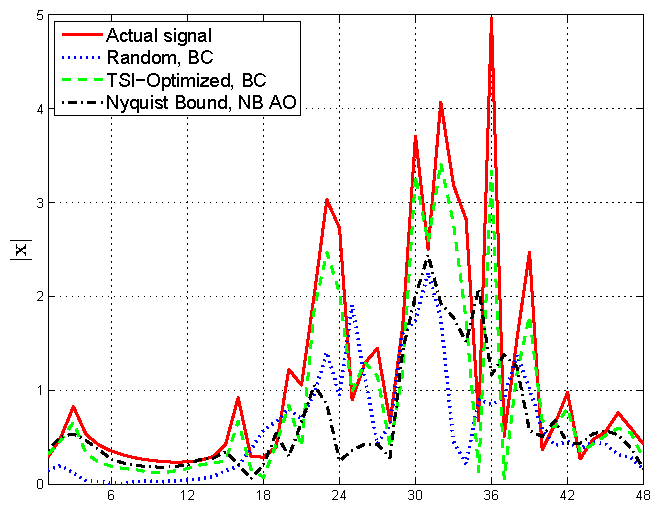Knowledge enhanced compressive radar imaging
Based on the compressive sensing theory, the incoherence between compressive sensing matrix and signal representation basis guarantees the recovery of sparse signals from sub-Nyquist sampling. Random sensing matrices including Gaussian matrix and Bernoulli matrix, are well-known to satisfy the incoherence requirement, which are also robust with any fixed signal sparse representation. However, random sensing only exploits the sparsity of signals.
In the forthcoming era of 5G, the knowledge acquisition becomes easier than before, which implies that, besides sparsity, more knowledge of signals can be exploited to improve the reconstruction performance.


Let us take the compressed radar imaging as an example. As Fig. 1 shows, conventional radar receivers use high-rate ADC to sample the received signals either in the analog domain or in the digital domain. Modern radars usually adopt wideband signals as radar waveforms to improve system performance, such as range resolution, imaging performance, etc. To address significant challenges due to high-rate ADC, compressive radar with low-rate ADC is an appealing solution, as shown in Fig. 2.

The compressive radar measurement vector is modeled as
where is the compressive sensing matrix,
is the discrete waveform matrix,
is the radar target profile to be estimated, and
is the noise term.
After modeling the probability distribution of , the signal to be estimated, the compressive sensing matrix can be optimized by minimizing the minimum mean-square error (MMSE) of the signal estimation as
or maximizing the mutual information between the compressive measurements and the signal as
Here, and
denote the statistical expectation and the mutual information, respectively. It is noted that both the objective functions are the implicit function of the compressive sensing matrix
. With the optimized compressive matrix, the radar target profile, i.e., the unknown vector
, can be estimated using the Bayes’ theorem.
Simulation
In Fig. 3, we compare the range profile reconstruction results for the narrowband reference and the Barker-coded waveform with both random and optimized compression. It is apparent that the low-bandwidth reference waveform does not provide enough resolution to separate closely spaced target peaks, but compressive sampling of the wider-bandwidth Barker Code improves detail in the reconstruction.

Product Offerings
VOCAL Technologies offers custom designed, knowledge enhanced compressive sampling solutions for radar, communications in the era of 5G. Our custom implementations of such systems are meant to deliver optimum performance for your compressive sampling tasks. Contact us today to discuss your solution!